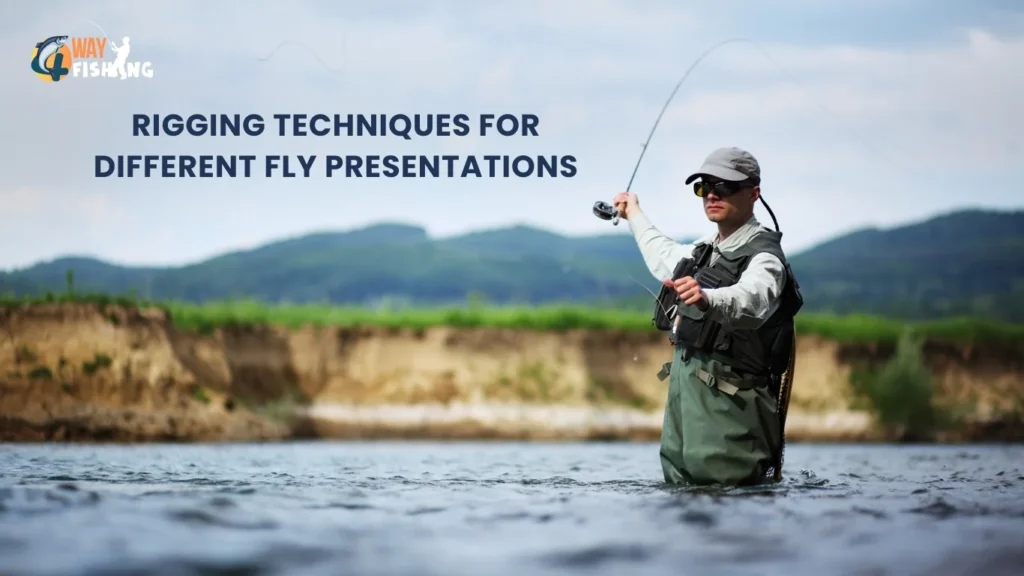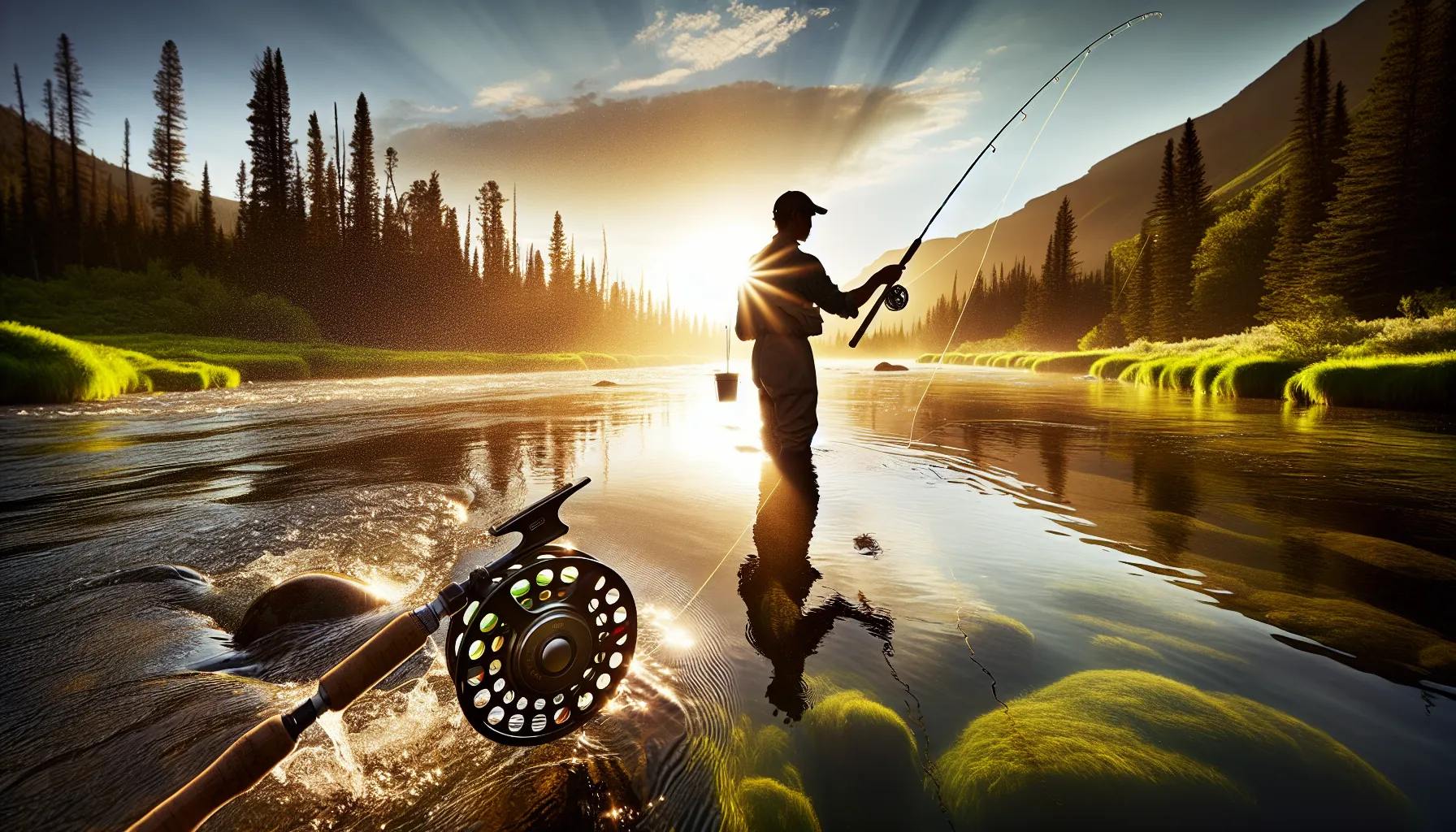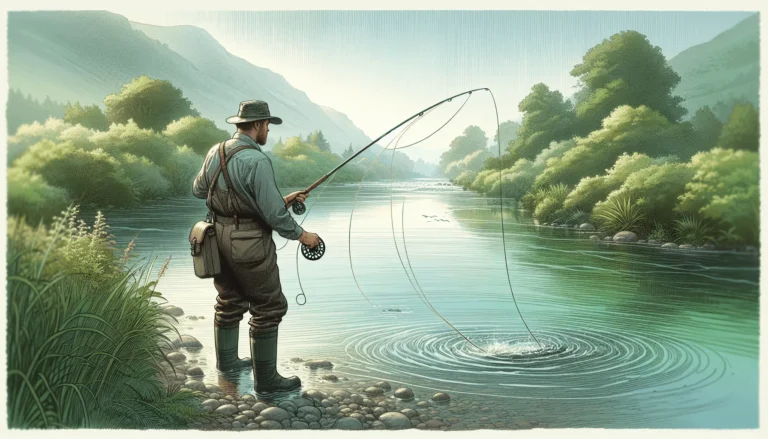Fly fishing with a spinning reel? It might sound unconventional, but it’s a technique that’s gaining traction among anglers looking to blend styles. This approach allows fishermen to enjoy the finesse of fly fishing while using familiar spinning gear. It’s particularly useful for those who want to try fly fishing without investing in specialized equipment or for situations where traditional fly fishing might be challenging.
This article will explore the essential gear needed for fly fishing with a spinning rod, including ultralight rods and line weight considerations. It will delve into rigging techniques for different fly presentations, such as dry flies and streamers, and how to set up a fly rod with a spinning reel. The piece will also cover casting and retrieving methods, touching on topics like tightlining and how to reel in a fish on a fly rod. By the end, readers will have a solid understanding of how to fly fish with a spinning rod and the pros and cons compared to traditional fly fishing.
Essential Gear for Fly Fishing with a Spinning Rod
Rods and Reels
When it comes to fly fishing with a spinning rod, selecting the right equipment is crucial. Anglers should opt for an ultralight or light rod, which offers the flexibility needed to cast smaller floats and weights . A 6.5-foot ultralight rod, such as the Fenwick Eagle Moderate Ultra Light, paired with a 2000 series reel, provides an excellent balance for this technique .
For those looking to enhance their fly fishing experience with spinning gear, a 7-7.5 foot fast action ultralight rod is recommended . If using lighter line weights of 2-3 pounds, an 8-8.5 foot medium action rod can be even more effective, as the softer action helps protect the smaller tippet and reduces break-offs .
Spinning rods designed for bass fishing can be versatile tools, suitable for a wide range of species from panfish to walleye, and even light saltwater use . These rods are known for their ability to handle big fish while still being sensitive enough to detect light bites .
Lines and Leaders
The choice of fishing line is crucial for successful fly fishing with a spinning rod. A braided mainline of 6-pound test is an excellent option due to its superior casting ability and sensitivity, allowing anglers to feel subtle bites . However, the visibility of braid can be a drawback, so it’s essential to add a clear leader .
For the leader, a 9-foot section of 4-6 pound fluorocarbon is recommended . Fluorocarbon is an ideal choice because it has the same refractive index as water, making it nearly invisible underwater . This setup combines the sensitivity of braid with the stealth of fluorocarbon, enhancing your chances of success.
Some anglers prefer using a 4-pound test monofilament line on a 5-foot ultralight rod for increased sensitivity . However, modern anglers are increasingly turning to low-stretch braids and fluorocarbons, which allow for better bite detection and hook-setting at a distance .
Read Also: Braided Line vs Mono: Pros, Cons, and When to Use Each
Flies and Lures
When fly fishing with a spinning rod, it’s important to have the right selection of flies and lures. Here are some essential options:
- Nymphs: Tungsten nymphs are slightly heavier than regular brass bead nymphs, requiring less split shot to cast or reach the bottom. This results in a more natural drift .
- Streamers: Beadhead Wooly Buggers are excellent flies for use with a spinning rod. Attach a small split shot 3-4 inches above the fly and cast quartering downstream. These can be retrieved at varying speeds, swung, or drifted down through the current .
- Strike Indicators: These tools help detect strikes while achieving a drag-free drift. They also provide enough weight to cast light nymphs without additional split shot .
- Split Shot: Most flies and monofilament lines are too light to cast effectively on their own. Adding split shot helps achieve the necessary distance. Adjust the weight to get your flies where you want them without getting snagged .
To enhance your fly presentation, consider using tippet rings. Tie these to the end of your monofilament fishing line and attach a length of fluorocarbon tippet. The fluorocarbon tippet used in fly fishing is more supple and typically has a lower diameter than monofilament used on most spinning reels, resulting in a better drift and increased sensitivity for detecting strikes .
Lastly, don’t forget to include a small, adjustable float in your gear. Choose the smallest float possible to minimize splash on the water, maintaining stealth and avoiding spooking the fish .
By carefully selecting and combining these essential gear components, anglers can effectively adapt their spinning equipment for fly fishing, opening up new possibilities and techniques on the water.
Read Also: Which is Better? British vs American Fly Fishing
Rigging Techniques for Different Fly Presentations

Nymph Rigs
Nymph fishing is an essential technique for anglers looking to catch trout, as these aquatic insects make up a significant portion of a trout’s diet. There are over 2,000 different types and sizes of nymph patterns, so selecting the right ones is crucial . When rigging for nymph fishing, anglers often use a two-fly setup. The first fly, typically heavier, acts as a weight to help sink the second, smaller fly .
One effective method for nymph fishing is to use a floating crankbait with two different nymphs attached below it. The heavier nymph should be tied first, followed by a lighter one. This setup allows the flies to drift near the bottom of the stream, where trout often feed . For added sensitivity and better drift, consider using tippet rings. Tie these to the end of the monofilament fishing line and attach a length of fluorocarbon tippet .
Some popular nymph patterns include:
- Copper John: Available in various colors, with green being particularly effective. It’s one of the heaviest nymphs and can be used as a sinker for a second fly .
- Prince Nymph: Recommended in bead head style, size 14 .
- Gold Ribbed Hare’s Ear: A widely popular pattern, best used in bead head style .
- Pheasant Tail Nymph: Effective in size 18 during fall and size 14 in spring .
For deep or turbulent water, anglers might use a size 10 nymph, while calmer or shallower conditions may call for a size 16 .
Dry Fly Setups
Dry flies, which float on the water’s surface, are typically the lightest flies. Despite their light weight, it’s still possible to fish them effectively with a spinning rod. The key is to attach a casting bubble to the line above the fly. This casting bubble serves two purposes: it provides the necessary weight for casting and floats along with the fly .
When rigging for dry fly fishing, consider the following:
- Use a small, adjustable float to minimize splash on the water, maintaining stealth and avoiding spooking the fish .
- Attach the casting bubble above the fly, allowing for proper presentation on the water’s surface .
- Master the skill of dead drifting, which can be easier with a spinning rod due to the lower diameter of the line creating less drag compared to traditional fly line .
Streamer Configurations
Streamers are larger flies that imitate baitfish or other larger aquatic creatures. When rigging for streamer fishing, consider the following techniques:
- Leader Setup: For streamer fishing, cut back the leader to 4-6 feet and use a tippet strength of 8 pound test or stronger. This setup results in fewer lost flies, better control, and faster landing of fish .
- Sinking Leaders: Consider using a sinking leader like Rio’s Versileaders. For rivers in Colorado, a 7-foot leader with a 5 ips (inches per second) sink rate is recommended .
- Tippet Selection: Use fluorocarbon tippet, which sinks faster and is more supple than monofilament. A 0X (15.5 pound) tippet is suitable for most streamer fishing situations .
- Fly Selection: Beadhead Wooly Buggers are excellent flies for streamer fishing with a spinning rod. Crimp a small split shot 3-4 inches above the fly and cast quartering downstream. Retrieve at varying speeds, swing the fly, or cast up and drift it down through the current .
- Line Choice: While a floating line can work, an intermediate or shorter sink tip line is often more effective, especially in larger rivers .
By mastering these rigging techniques for different fly presentations, anglers can effectively adapt their spinning gear for fly fishing, opening up new possibilities and techniques on the water.
Casting and Retrieving Methods
Roll Casting
Roll casting is a versatile technique favored by many professional anglers. It offers a balance between accuracy and stealth, making it ideal for various fishing situations. To execute a roll cast, the angler starts with the line about 2-3 feet off the rod tip. The bait is then swung over the top and around the back, shooting off at the bottom of the rod in a low trajectory towards the water .
One of the key advantages of roll casting is its ability to produce a silent entry into the water. This is particularly useful when targeting easily spooked fish or fishing in clear, calm conditions. To enhance this quiet approach, anglers can employ a technique called “feathering” as the bait nears the water. This involves placing the thumb on the reel to slow the line and raising the rod tip simultaneously, allowing the lure to lay gently on the water surface with minimal splash .
Roll casting can be performed both forehand and backhand, offering flexibility when fishing around obstacles or from different positions on a boat. For a backhand roll cast, the motion is similar, but the top hand makes a small circle while the back hand simply rotates .
Overhead Casting
The overhead cast is perhaps the most common and straightforward casting technique used in spin fishing. It involves taking the rod by the grip in the right hand (for right-handed anglers) and flipping open the bail with the left hand. The line is then hooked with the index finger of the right hand, applying pressure to control the release .
To execute the cast, the rod is flipped back over the head and then snapped forward towards the target. The key to a successful overhead cast lies in the timing of the line release. As the rod begins to bend in the opposite direction during the forward motion, the angler releases the line from their index finger .
A variation of this technique is the two-hand overhead cast. This method is identical to the standard overhead cast, with the addition of holding the line from the spool to the first eyelet in the left hand. As the rod is cast with the right hand, the left hand moves forward in unison, releasing the line as the rod tip snaps forward .
For situations where overhead casting is impractical due to obstacles, anglers can employ a sidearm cast. This technique uses the same line trapping and releasing methods but involves casting sideways rather than overhead .
Stripping Techniques
Stripping is a crucial retrieval method in fly fishing, particularly when using streamers or other larger flies. The effectiveness of stripping often depends on the angler’s ability to vary the retrieve and impart lifelike action to the fly.
One effective approach is to fish streamers by casting quartering upstream and using fast strips to keep ahead of the current speed. This technique, which is easier to master with a spinning rod, can significantly increase catch rates .
Anglers should focus on varying their retrieve to induce more strikes. Small pauses, allowing the fly to dip and dart, are often more effective than a simple, steady retrieve. This technique of adding “life” to the flies is generally easier to learn with a spinning rod and translates well when transitioning to fly gear .
When playing and landing fish, there are two main methods for line management: the strip method and the spool method. The strip method involves using the management loop behind the “trigger” finger to play a fish. While this can work for smaller fish, it can create challenges with larger catches, potentially leading to tangles and reduced control .
Many experienced anglers advocate for the spool method, which allows for quicker fish landing and better line management. In this technique, after setting the hook, the angler keeps the rod in a high set position with the trigger finger pinching the line to the cork grip. The non-dominant hand is then used to spool the line tight, providing better control and allowing for a more offensive approach to landing the fish .
By mastering these casting and retrieving techniques, anglers can significantly improve their efficiency and success rates when fly fishing with a spinning reel.
Conclusion
Fly fishing with a spinning reel offers a unique blend of traditional and modern angling techniques. This approach has an impact on both beginners and experienced anglers, providing a gateway to explore fly fishing without the need for specialized gear. By mastering the essential equipment, rigging methods, and casting techniques discussed, anglers can enhance their skills and broaden their fishing horizons.
In the end, the ability to fly fish with a spinning rod opens up new possibilities on the water. It allows anglers to adapt to different fishing conditions and target a wider range of species. While it may not replace traditional fly fishing entirely, this hybrid approach serves as a valuable tool in any angler’s arsenal. So, whether you’re a seasoned pro or just starting out, give this method a try to add a new dimension to your fishing adventures.
FAQs
Can I use fly fishing flies with a spinning reel?
Yes, using flies on a spinning reel can be quite effective. It helps beginners learn crucial line manipulation skills more quickly. Additionally, it’s easier to achieve and maintain a tight line connection, which can be beneficial for effective fly fishing.
What is the best way to fish for trout using a spinning reel?
To effectively fish for trout with a spinning reel, position yourself slightly upstream of the targeted area. Cast upstream and across towards the intended spot, then reel just enough to initiate the lure’s movement. Allow the current to carry the lure, maintaining its motion to attract trout.
What types of lures are suitable for a spinning reel?
For spinning reels, lighter lures such as small shaky heads, squarebill crankbaits, and drop shot rigs are ideal. These setups work well until you reach lures around 3/8 oz in weight, beyond which a baitcasting setup might be more appropriate due to the limitations in casting heavier rigs with a spinning reel.
Is it feasible to use Euro nymphing techniques with a spinning rod?
Euro nymphing can indeed be adapted for use with a spinning rod. You will need to add sufficient weight to your line to compensate for the different mechanics compared to using a traditional fly rod. This adjustment allows you to maintain the necessary depth and control for effective nymphing.




